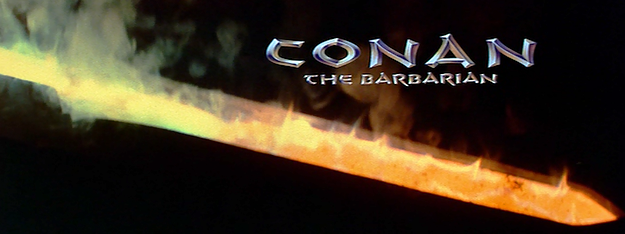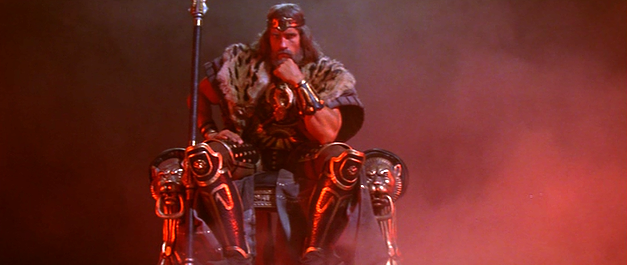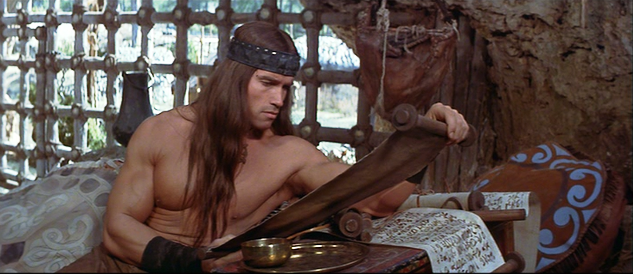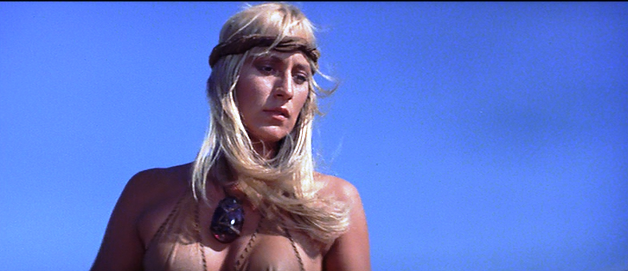“Between the time when the oceans drank Atlantis and the rise of the sons of Aryas, there was an age undreamed of. And unto this: Conan, destined to wear the jeweled crown of Aquilonia upon a troubled brow. It is I, his chronicler who alone can tell these of his saga. Let me tell you of the days of high adventure…”
-Opening Narration, Conan the Barbarian (1982)
Now four decades old, John Milius’s Conan the Barbarian (1982) commences with imagery of a sturdy sword being forged in fire and snow. And indeed, that forging process is the movie’s central metaphor for Conan himself, and his evolution from child to man.
This hero’s life may be a “tale of sorrow” at points, according to the voice-over narrator, but it’s also a tale of learning, of Conan’s growth and development. This is a process which culminates in a triumphant apotheosis and is revealed -- majestically and mysteriously -- in the film’s valedictory shot.
From orphaned boy to pensive king in the span of one movie, Conan is shaped and tempered like a sword, until he becomes, himself, the flesh equivalent of that one dependable element in all of human life: steel.
In some ways, however -- and this is where the film proves truly clever -- Conan’s story is also our very own.
We also face adversity and we also overcome it. We survive.
Accordingly, one impressive quality of John Milius’s cinematic telling of Conan’s tale is the manner in which the production’s various fantasy set-pieces -- from the Wheel of Pain to Thulsa Doom’s cult -- form a rough analogy for the places life takes us…whether we want to visit those particular places or not.
Sometimes, our life is pure drudgery and unending routine, just like Conan pushing that damned wheel for fifteen or so years.
And sometimes we go questing for something “outside” ourselves so as to fill an interior, emotional void. That search is reflected in Thulsa Doom’s belief system.
Yet we can’t be healed from the outside in. Instead -- by Crom -- the process of becoming whole must start within us. Through all life’s trials -- and in keeping with the film’s opening quote from Nietzsche-- “what doesn’t kill us makes us stronger.”
To this day, Conan the Barbarian remains the finest iteration of Robert E. Howard’s hero on the silver screen. This is so because as a work of art it concerns explicitly those things that don’t kill Conan, but which nonetheless prepare him to be the man – and king -- he must become.
Conan the Barbarian is also pitched at a far more adult or grown-up level than either Conan: The Destroyer (1984), or the twenty-first-century re-boot, Conan the Barbarian (2011), a fact which renders the film more accurately about the vicissitudes of real life…even though it is a fantasy of the fictitious Hyborian Age.
This Conan gets drunk, fucks a lot, faces emotional set-backs, and exacts bloody revenge. He hasn’t yet been homogenized for modern popular culture consumption and that fact makes Conan the Barbarian a thrilling, unpredictable, and occasionally quite romantic fantasy film.
“He is Conan, Cimmerian. He won’t cry. So I cry for him.”
A vicious raiding team attacks the village of Cimmeria, and young boy named Conan watches as his blacksmith father (William Smith) falls in battle. Conan then watches -- up close -- as his mother is decapitated by a warrior, the evil and strangely magnetic Thulsa Doom (James Earl Jones).
Conan is sold into slavery, and grows up at the Wheel of Pain. There, he lives a life of drudgery, forever pushing one of the wheel’s heavy spokes.
When he is mature -- and fit -- Conan becomes a champion of the arena, and a favorite of the people.
Once educated, Conan escapes from his masters and goes out in search of the man who killed his parents all those years earlier.
After battling a witch, and teaming up with a thief, Subotai (Gerry Lopez), Conan pursues the rapidly-spreading “Snake Cults” across the land. In one town, he meets up with the beautiful warrior Valeria (Sandahl Bergman), who is interested in robbing a snake temple.
Together, the three wanderers steal the expensive jewels inside the temple, and defeat a giant snake. Afterwards, Conan and Valeria fall in love, realizing that they are…soul-mates.
Soon, King Osric (Max Von Sydow) summons Conan and his friends to his kingdom. The King reveals that his daughter (Valerei Quennessen) has fallen under the sway of Thulsa Doom, and gone to his temple as a priestess and slave. Osric offers to make Conan rich if he can bring his daughter back.
With Valeria reluctant to undertake the quest, Conan goes on his own. He is promptly captured by Thulsa Doom, crucified, and left to die in the desert.
Fortunately, Subotai, Valeria and a friendly wizard (Mako) nurse Conan back to health. Valeria even beats back the soul-takers of the Under World by night to prevent them from carrying away Conan.
With his team assembled, Conan prepares to rescue the princess, and exercise his final revenge against Thulsa Doom.
But the great warrior has one more grievous loss to face…
“Now they will know why there are afraid of the dark. Now they learn why they fear the night.”
Conan the Barbarian opens with a montage of a sword being forged, and these images are run in tandem with the main credits.
Throughout this forging process, there are two sets of hands on this specific sword, and significantly, they belong to Conan’s mother and father.
We see the sword born in fire and cooled in snow.
We see the hands of Conan’s father chiseling fine detail onto the hilt.
We see Conan’s mother tenderly wrapping the sword’s handle with her delicate hands.
These images seem to be about preparing a weapon, a blade, but they actually transmit something else: the love of Conan’s parents for their only child.
By tending to the sword with such love and devotion, we understand that his parents are not only shaping the blade, they are shepherding and shaping Conan himself.
The focus of this imagery is not just on the sword itself (the surrogate for young Conan), but specifically on the hands doing such delicate and hard work. Watching, we understand the message. This is what good parenting often feels like: very hands-on.
The film then cuts to a scene of Conan’s father shaping and tempering the young man, telling him of his belief in God -- Crom -- and of the Cimmerian philosophy of steel. Conan’s father thus shares his religious faith with his son, and he does it in a kind of spiritual location, atop the most beautiful, snow-capped mountains imaginable. The sky and clouds seem within reach.
These opening scenes thus reveal that Conan may live a harsh life, but that he is loved…protected.
In short order, however, this cocoon of total love is destroyed. Thulsa Doom arrives in the village with his raiding party, and -- as if to visually transmit the horror of the villain’s actions -- Milius cuts to a shot of young Conan and his mother cowering in the snow of Cimmeria… in the very center of the rectangular frame.
Bracketed on both sides of Mother and son are the armored, merciless warriors of Doom. The positions of the guards here reveal the level of danger. Conan and his Mother’s space in the frame has been abbreviated, cut-off. They have nowhere to run, no recourse.
And then, Milius’s selection of shots transmits the idea of loss.
Conan is grasping his mother’s hand tightly when Thulsa Doom decapitates her.
But Conan doesn’t see the death blow. Instead, his mother -- who had been holding his hand -- falls away from him, out of frame, and Conan is left holding nothing…only air.
This shot expresses the sudden emptiness of his life, and the reverse angle reveals the thing that shall replace love in Conan’s life…vengeance.
Specifically, the reverse angle on Conan at this juncture reveals Thulsa Doom standing symbolically in the position Conan’s mother had occupied.
From this view, Conan’s hand and arm seem curled not around “nothing,” but around the imposing Doom.
The family has been destroyed. Love has been replaced by hatred in the young boy’s heart. And Milius’s choice of composition perfectly reflects this shift.
The next scene in Conan the Barbarian is among my very favorite from the film. The boy Conan pushes the Wheel of Pain for years -- through sunlight and darkness, through winter and spring -- until he is all grown up.
Arnold Schwarzenegger is introduced as the adult Conan in this montage, coming around on the final revolution of the wheel. First, we see only his (strong) legs, but then we see his adult countenance, his furrowed brow and cunning eyes.
A less clever film might have simply faded out on young Conan as a slave, and faded in years later, with him as an adult. There might even have been a chryon stating, flat out “20 years later.” But the Wheel of Pain sequence not only introduces us to “adult” Conan, it adroitly reveals the essence of the character’s life. It is a life of repetition, routine, hardship, grunt-work, labor, and struggle.
The years do not pass quickly for Conan.
Instead, they pass tediously and with back-breaking sweat, and as I noted in my introduction, the Wheel of Pain thus seems like a perfect metaphor for the human existence.
Some people might say adolescence and high school are wheels of pain. Others might conclude that a 5-day-a-week job is a candidate for another wheel of pain.
You can pick your poison, but Conan the Barbarian finds a perfect way to express Conan’s woes, and the fact that his years pass unhappily, without love and, importantly, without adventure. He is trapped in this Hell, doing the same thing over and over again, dreaming patiently of revenge, but never being able to enact it.
The snake cult of Thulsa Doom, I believe, represents another aspect of human life: false wisdom.
The cult’s wisdom is not the wisdom of parents who love you no matter what, but the wisdom of people whose motives may be less than benevolent. In this case, individuality is squashed as thousands of men and women dress identically in white and listen rapturously to Doom’s pronouncements and sermons.
But the landscape around the cult is of special note in terms of the visuals: the trees and the land seem dead, a representative of the very “emptiness” that Doom not only creates, but actually promises for his devoted acolytes. Notice the wretched, gnarled trees that line the path to Thulsa Doom’s temple, specifically. There is little life, color, or vitality there.
There have been those writers and reviewers over the years who suggest a certain right-leaning or tilt to Conan the Barbarian, and I concur with that viewpoint. For example, Thulsa Doom’s cult seems very much like an intentional rejection or critique of the 1960s hippie movement, and counter-culture family units such as the commune.
In 1982, there would have been a fairly recent example of just such a communal life gone terribly wrong, namely the Jonestown Massacre of November 18, 1978, wherein over 900 people were killed by “guru” Jim Jones.
But if one gazes at Conan the Barbarian in broad terms, the story concerns a man (Thulsa Doom) -- a leader -- who creates useful “emptiness” in his followers by taking them away from their parents, away from the traditional family units. The shot I noted above -- with Doom stepping metaphorically into the visual space of Conan’s mother -- reflects this very notion.
Specifically, Doom robs Conan of his parents. But importantly, he also takes away King Osric’s daughter, the princess. This act so grieves Osric that wealth and power mean nothing to the king. “All that’s left,” he tells Conan mournfully, is “a father’s love for his child.”
But Doom replaces the love of parents -- which we saw so vividly expressed in the film’s opening “forging” montage -- with sexual desire, hero worship, group anonymity, and mysticism. Perversely, he calls his cult “The Children of Doom,” and that very name suggests how he has twisted family values to his own ends.
In fact, Thulsa Doom attempts to create spiritual “emptiness” -- to be filled by the snake cult -- in Conan twice. First by killing his parents, and secondly by murdering the love of his life: Valeria.
The most affecting moments of Conan the Barbarian involve the dedication and commitment that these soul-mates and lovers show one another. Valeria saves Conan from the under-world and, finally, her spirit saves him in battle.
The latter act is suggestive of a love that lasts beyond mortality, and again, that act of love very much stands in contrast to the selfish and empty love that Thulsa Doom offers his followers.
In the end, Conan loses Valeria and all he is left with is the thing his father promised him as a legacy all those years earlier, “the discipline of steel.”
He cannot trust men or women to be at his side, as his father indicates. But this is not because other people are bad, but because death takes them. In realizing this – and in truly knowing love -- Conan becomes a hero who is much deeper than his early, infamous commentary, “crush your enemies, hear the lamentation of their women…” suggests.
Some scholars and reviews have suggested that there is something inherently fascist about Conan the Barbarian, but in truth, it seems far less fascist in design and execution than a saga like Star Wars. There, for example, only the people with the right kind of blood (Midichlorians…) can harness the power of the Force.
By contrast, Conan here becomes king not because of any pure blood he possesses, not because of ancestry or heritage, but, according to the dialogue, by “his own hand.”
That description suggests the opposite of fascism, and is an assertion instead of good old-fashioned, self-reliance. Conan takes the (terrible…) hand he was dealt and, in spite of his woes and sorrows, becomes a wise King.
A chronicle of “high adventure” in an “age undreamed of,” Conan the Barbarian succeeds and endures because its visuals so ably express Conan’s story. From the opening sword-forging montage to the visualization of “emptiness” (and thus death) at the heart of Doom’s cult, the film’s meaning is transmitted beautifully by symbolic imagery.
Beyond this, the film is gorgeous to look at in terms of its natural vistas. Today, of course, the lack of CGI is very refreshing. There is something three dimensional and “real” about the landscapes and creatures Conan encounters in this film, and we have a better sense of him as a person and as a hero because we feel he exists in real environs, not merely in front of a green-screen.
Similarly, the film’s final battle represents a dramatic high-point because Milius doesn’t take it for granted that Conan will win merely because he is a great warrior with bulging muscles.
Instead, we witness Conan’s intense preparation of the battle-field before the fight. We see him set up booby traps, and think through all the angles. We thus get the idea that he wins the battle for two reasons.
The first is that he assiduously prepared a strategy to defeat the army…meaning that Conan is smart and cunning.
And secondly, Conan wins, because Valeria intervenes in his affairs, from the Underworld. He has forged so meaningful a relationship with her -- again, the polar opposite of Doom -- that even death cannot keep his dearest ally from aiding him in a time of need.
It has always been fashionable to bash Arnold Schwarzenegger as an actor, and Conan the Barbarian is no exception.
But unlike many other athletes/fighters turned actors (like Steven Seagal, for example), Schwarzenegger always showcases a sense of humor, a self-deprecating side of himself. There’s a grace and humanity in his best performances that make audiences love him.
Arnold may look super-human and perfect, but he’s also got that kooky accent, those bulging eyes, and a goofy grin. He’s actually pretty good as Conan because he projects a distinctive personality and sense of humor as the hero. You sense that his Conan possesses an inner life, and isn’t just a dumb hulk.
Sandahl Bergman is also perfect as Valeria, making the no-nonsense role her own. She plays a strong woman, and Conan's equal on the battlefield (and presumably elsewhere...). Bergman projects toughness and tenderness in equal measure, and has no stereotypical "damsel in distress" moments whatsoever.
Bergman's best moment, in my opinion, involves her decimation of Thulsa Doom's forces, while Conan is carrying away the princess. Valeria ruthlessly, efficiently -- and magnificently -- eliminates what seems like an army of warriors, and Bergman is poetry in motion. Also impressive here is the fact that without much dialogue, Bergman is able to powerfully express Valeria's devotion to Conan.
Conan the Barbarian captures the spirit of Robert E. Howard's stories, if not always the exact details, and that is simply the best that a fan can usually hope for, since movies and books are such different art forms. Yet at the time of its release, Conan the Barbarian was also bashed as being too violent, too sexual, and too politically incorrect, despite its fidelity to the source material. Today, such qualities actually grant the film a sense of verisimilitude that many other fantasy epics decidedly lack. It’s so refreshing to see an R-rated fantasy.
This version of Conan has a lot of heart, a lot of verve, and enough steel to kick-start a franchise. And that’s exactly what happened.




























Good stuff. Thank you for writing this.
ReplyDelete